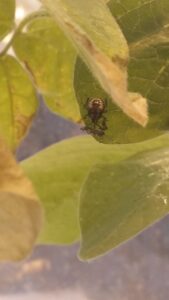2016 Annual Report for GNE16-132
Identifying realized predation on BMSB (Halyomorpha halys, Stål) and host plant impacts
Summary
The goal of this work is to assess the affect of predators on Brown Marmorated Stink Bug (BMSB) in the presence of alternate prey in greenhouse mesocosms. The first replicate of the experiment is currently underway, with plant growth and insect abundance assessments occurring twice per week. This replicate will conclude on 22 December and two additional replicates will be completed in early 2017. Necessary supplies for these replicates have been acquired and soybean plants for the upcoming second replicate have already been planted. Due to availability issues, the Nabis spp. and Coccinella septempunctata were not used as planned. Instead, Podisus maculiventris and Hippodamia convergens constitute the predator treatments for this experiment. Additionally, an alternate stinkbug treatment was removed from the experiment due to rearing issues.
Objectives/Performance Targets
1. Quantify the rate of predation experienced by BMSB nymphs on soybean plants in greenhouse mesocosms
2. Quantify rate of predation of BMSB in the presence of alternate prey
3. Determine the effect of predator presence on soybean yield
These objectives are currently being addressed by the on-going experiment. The first objective can be anecdotally addressed by the attached photo, wherein a Podisus maculiventris nymph was seen consuming a BMSB nymph in the greenhouse mesocosm. This agrees with results from earlier work I conducted to test various predators for consumption of BMSB nymphs in less natural experimental arenas.

Accomplishments/Milestones
Although the experimental phase of this project has just begun, several preliminary objectives had to be addressed before the experiment could start. These primarily involved the acquisition of the living organisms to be used in this experiment. Soybean seed and potting soil were acquired from local farm suppliers but the predatory insects I proposed to work with in this study are not commercially available. These predators (Nabis spp. and Coccinella septempunctata) were sampled in large quantities during the fall from buckwheat and materials to support reproducing colonies of these species were procured. However, neither species reproduced in colony after 2 months, thus commercially available alternatives had to be sought. Based on behavioral similarities and similar feeding methods, Podisus maculiventris was selected to replace Nabis spp. and the convergent lady beetle, Hippodamia convergens, was selected as a replacement for the seven spotted lady beetle, Coccinella septempunctata. Small quantities of two native stink bug species were acquired from the USDA: ARS Beneficial Insect Introduction Lab in Newark, DE but these species also failed to successfully reproduce in colony. Once the predator and prey treatments had been decided on, the experiment began post haste and is currently underway.
Impacts and Contributions/Outcomes
Although the first replicates from this experiment have only just begun, the initial results are promising. As evidenced by the above photo, Podisus maculiventris has been observed feeding on BMSB nymphs in experimental cages, and BMSB abundances in the presence of these predators is generally lower than other treatments. Additionally, assessment of new vegetative growth has shown a ~50% increase in the number of new nodes per plant in treatments without herbivores (regardless of predator presence). Additionally, plants in no-predator treatments have fewer nodes than those growing with predators (regardless of prey species). Aphid presence, in general, seems to have a much more deleterious effect on overall plant health than BMSB alone and thus, plants in cages with Hippodamia convergens have fewer aphids and more vegetative growth. These results are extremely preliminary and have not been subjected to any statistical analyses yet, but treatments seem to be affecting the plants and insects as predicted and these trends are expected to continue.
Collaborators:
Assistant Professor and Tree Fruit Extension Specialist
Rutgers University
121 Northville Rd
Bridgeton, NJ 08302
USA